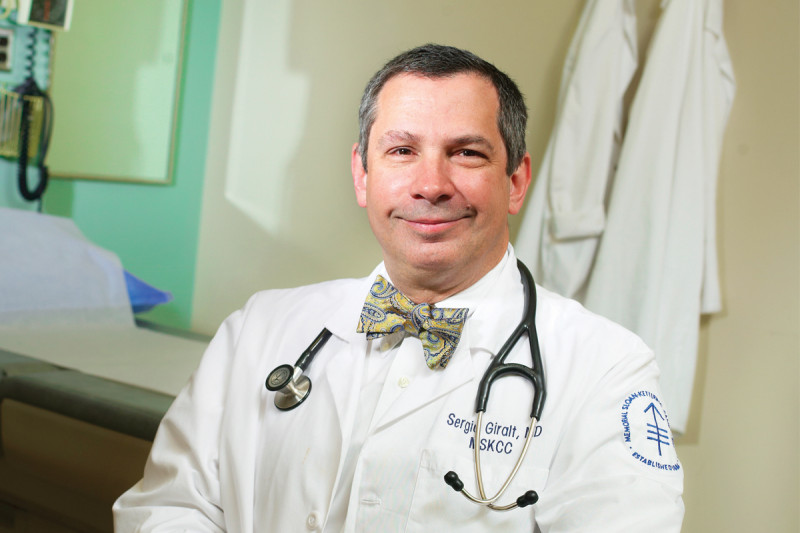
Sergio A. Giralt
I developed a passion for cancer medicine while doing my internship and residency training at the Good Samaritan Hospital in Cincinnati, Ohio. In fact, I recall being the only hematology student in my class who was eager to see patients with leukemia. I think some of my peers felt medicine had little to offer cancer patients — and that was to some extent true back then, in the 1980s. But I wanted to work in a field where there was a lot to be done.
I did my fellowship in hematology/oncology at MD Anderson under the guidance of Richard E. Champlin. A pioneer in bone marrow transplantation, he had just returned to the United States from the Soviet Union, where he led efforts to save victims of the Chernobyl disaster. He has supported me throughout my career and remains a good friend. Among the many pieces of advice he gave me — and something I pass on to the residents and fellows I train — was, “If you think an idea is worth exploring, don’t be afraid of challenging the status quo.”
In the early 1990s, a transplant was rarely an option for people older than 60, because the treatment was inevitably very intense. In a traditional transplant, patients are first given ten times the dose of conventional chemotherapy or radiation to kill cancer cells that have become resistant to normal doses. Then, to rescue the patient from the toxic side effects, new bone marrow cells are transplanted — either the patient’s own cells or cells from a matched donor.
When I first told Richard I wanted to investigate whether patients could be given less-intensive doses of chemotherapy and still benefit from a donor-derived transplant, he didn’t think such reduced-intensity transplants would be effective. But based on observations my colleagues and I had made in the clinic, I convinced him that, as he once put it in jest, “what Sergio had come up with seemed so far-fetched that it might actually work.”
And the reduced-intensity transplants did work, as we learned from a small study in leukemia patients, many of whom were too old to have a traditional transplant. Our discovery was extremely satisfying because it established we could now offer a lifesaving treatment to a large group of patients for whom no treatment options previously existed.
From there, my research interests gravitated toward making transplants more effective and less burdensome for patients with multiple myeloma, a disease often diagnosed in older people. Though a transplant is the best treatment, many of our myeloma patients don’t feel well afterwards; they suffer from pain, weakness, fatigue, and other side effects.
My colleagues and I are exploring the underlying causes of such symptoms, looking for ways to alleviate them. Hopefully, what we are learning in myeloma could be applicable to other cancers as well.
I love Houston. It’s where I grew up as a transplant physician, and where I left 750 cancer survivors who were my patients. Nonetheless, when I got the opportunity to join Memorial Sloan Kettering, it was an offer I couldn’t refuse. The Center’s transplant program is exceptional, with a wonderful history. The first successful transplant between a patient and an unrelated donor was performed here, in 1973. And Memorial Sloan Kettering physicians have pioneered many widely used transplant approaches, including one called T cell depletion, which has been very successful in preventing graft-versus-host disease (an acute immune complication that may occur following a donor-derived transplant).
Going forward, our goal is to increase access to and improve outcomes of stem cell transplantation. We are developing trials looking at more-effective ways to prevent complications — and making transplants available to more people who could benefit. For example, we are investigating new methods to reconstitute a patient’s immune system following a transplant, and protocols in which bone marrow cells could be given in higher doses.
We will be offering some patients transplants in an outpatient setting and exploring the use of telemedicine, which in the future could allow patients to spend fewer days in the hospital and not need a caregiver 24 hours a day, seven days a week.
We are blessed with outstanding resources — especially human resources — that allow us to move the field forward. Transplant is an intricate team game. On our team are many of the nation’s most experienced transplant doctors; scientists working at the leading edge of stem cell and immunology research; nurses who are experts in their field and passionate about caring for their patients; and skillful ancillary staff, including therapists, social workers, and administrators.
It’s a great privilege to be leading such an incredible group of professionals, who all do their utmost each day to return our patients to a life free of cancer and the aftermath of treatment.
I am confident that with this team of dedicated individuals we will become the premier stem cell transplant service in the world, and that patients and physicians who are faced with the need for a transplant will be asking the question: What would they do at Memorial?

